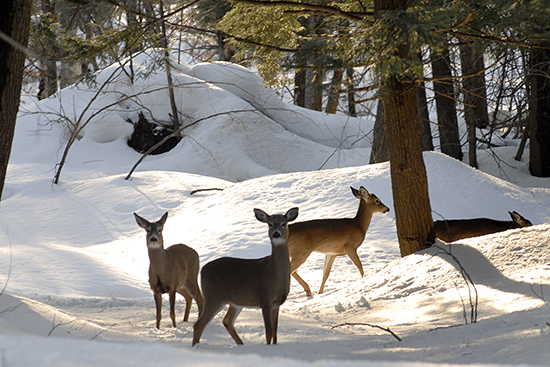|
Maple Sugaring Around New York State

There are more than 2,000 maple sugar farms in New York State, which boasts the largest number of tappable sugar maple trees in the United States. If you'd like to learn how maple syrup is made, there are numerous "sugaring" operations throughout the state that offer open houses and tours during two weekends in March (3/18 and 19; 3/25 and 26) . Check the New York State Maple Producers Association's website to find a sugaring open house near you.
Five Rivers Environmental Education Center (Albany County) is hosting maple sugaring open houses Saturdays, March 11, 18 and 25 from 1:30 to 3:30. You'll get to twirl a brace drill, pound a spile, inspect sap flow in the sugarbush, enjoy the aroma of sap boiling down and take the maple taste test. A local maple producer also will be available to answer any questions.
Read "Sap to Syrup", an article about maple sugaring in the February 2017 issue of the Conservationist.
Watchable Wildlife: Bashakill Wildlife Management Area

Sullivan County
Located at the southern end of the storied Catskill Mountains, the Bashakill Wildlife Management Area is home to one of the largest freshwater marshes in the state. Wetlands are surrounded by deciduous woods and shrublands, attracting abundant and diverse wildlife. Hiking into the area's upland woods provides the best opportunities to view wildlife. Landscapes of alternating forests and clearings have attracted white-tailed deer, which abound here. Look for them at first light and at dusk. Bear are found in the area but are not frequently seen. Aquatic mammals you may observe include beaver, muskrat and otter. A variety of raptors can be seen scanning clearings, shrublands and deep woodlands for small mammals and birds.
Visitors can view wildlife from a car or on foot. One trail follows an old railroad right-of-way and has three observation towers, while another follows the towpath along the canal dug by the Delaware and Hudson Canal Company.
Abundant Snow Geese at Cayuga Lake Wildlife Management Area

Seneca County
Snow goose hunting is among the most challenging and rewarding types of waterfowl hunting. Areas where large numbers of snow geese occur at this time of year include the Finger Lakes region, the St. Lawrence Valley, and the upper Hudson and Champlain Valley regions. Snow goose hunting should be exceptional at Cayuga Lake Wildlife Management Area (WMA) in the Finger Lakes. Their populations are high, and hunters have until April 15th to take up to 25 geese per day. The WMA is on the northern tip of Cayuga Lake, just south of the Montezuma National Wildlife Refuge and has 225 acres of cattail marsh and wooded swamps. See the Cayuga Lake WMA and Snow Goose Conservation Order webpages for more information.
Nature Notes: The expanded population of snow geese now make the species the most abundant waterfowl in North America.
How'd Those Stripers Get There? ECO Report
On January 4, while on patrol at the Haverstraw Marina, ECOs Maxwell Nicols and Andrew Kostuk received a tip that fishermen were catching striped bass and tossing the fish into the weeds behind them. After watching the fishermen for a while, the ECOs confronted the men and asked if they had any luck fishing. The men said they hadn't, but after a brief search, Officer Nicols pulled a striped bass, still alive, from the weeds within feet of where the men had been fishing. Further investigation led to a second striper. The men were instructed to pack up for the day and were escorted back to their vehicles, where they were issued tickets for possession of striped bass out of season.
Upcoming DEC Events
Conservationist Magazine

If you haven't seen the February issue of Conservationist magazine, check it out. A number of readers contacted us regarding the article about the economic renaissance of the once-contaminated Buffalo River. We also heard from readers who enjoyed reading about the important work our forest rangers do, including the daring winter rescue of two lost hikers on Algonquin Peak. The February issue also contains incredible photographs celebrating New York's timeless beauty by Joe LeFevre, and interesting articles about maple sugaring and phenology (tracking the natural events occurring all around us).
There's all this and much more in the latest Conservationist. Don't miss it! Subscribe online or call 1-800-678-6399.
|






